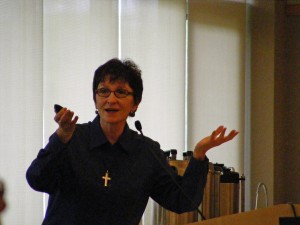News » Could Your Worn Jeans Save the Earth?

Kathleen-Deignan-Patch
Or at least your home? A sustainability conference, sponsored by the Sisters of the Divine Compassion, addressed different ways to save energy, money at home, in business and in government.
Originally posted at WhitePlainsPatch by Duncan Raymond on May 11, 2011
Could blue jeans save the world? Maybe.
At a conference on sustainability sponsored by the Sisters of the Divine Compassion this Wednesday at Pace Law School’s Justice Institute building, dozens of people—from politicians to architects to corporate leaders—spoke of ways to conserve energy, preserve the environment, roll back losses the earth has felt recently, and save money in the process.
And blue jeans were front and center.
“Not Levis,” said Habitat for Humanity executive director James Killoran, “Gap.” In a new twist on recycling, the blue jeans are shredded and then reformed as insulation, “the thicker, the better,” Killoran said.
Blue jeans insulation is just one of dozens of ways, large and small, that may help reduce the impact modern living has on the ecology. And it’s only one of the things the conference organizers hope people will adopt to lessen their personal footprint.
“We’ve labored to create a Wonderland,” said Kathleen Deignan, Professor of Theology at Iona College., “but it’s brought the vital flourishing of 65 billion years of evolution to an end. We’ve moved from wonder world to waste world in two centuries. Our challenge, is to take up the great work of our age.”
That work, she said, is one that requires an evolution in human thought and patterns of being that will spur a transition from a technological age to “a more benign mode of human presence”.
“Sustainability begins at home,” Deignan said. “It begins with us.”
The way forward may be behind us. Walter Sedovic and Jill Gotthelf’s architecture firm specializes in restorations, recently having completed the Eldridge Street Synagogue in Manhattan, as well as the Hudson Library, an 1818 structure made of granite.
“We are living in the green decades,” Sedovic said. But the media conflates “green” and “sustainable”. “We’ve got green Coca Cola and organic water. We’ve got green charcoal you can burn with green matches.”
“Traditional building technologies showed the way to sustainability without using the word “green”,” Sedovic continued.
The library in Hudson, NY, was a perfect example of sustainability, Sedovic said. The building materials and design were local and durable. The building was oriented to the prevailing winds, which reduced heating costs (based on coal when it was built), and to the Hudson River.
Reconstruction is often more sustainable than new construction, he said. He paid particular attention to maintenance, pointing to replacement windows. While it’s true that new, weather tight windows contain heat and cooling, older windows often contributed to air circulation or solar heating.
Maintainence is key, he said. Interventions, rebuilding or redesigning, should be appropriate to the project. Perhaps, blue jeans insulation is all you need.
There’s money to be had in energy savings, too. Peter Harkham (D.-Katonah), Majority Leader on the Westchester County Board of Legislators, pointed to the savings the County has saved with its fleet of hybrid cars, heating and air conditioning retrofits at the County Center, and by the use of solar panels.
The County continued a sales tax exemption for home solar panel installation, a move that could save individual home owners thousands of dollars, on Monday. Westchester County will also require recycling of plastics labeled three through seven beginning in June.
White Plains Mayor Tom Roach spoke as well to give attendees inspiration for the hard work that lie ahead.
“The environmental issues have not changed,” he said, since the first time he heard of and participated in Earth Day. But he pointed to improvements in diesel emissions through the use of exhaust filters and better fuels and to improved storm water drainage.
“I’ve seen the Hudson River transform into the beautiful thing it always was,” he said. “This was hard work..”
What can you do? Use flourescent or L.E.D. light bulbs. LEDs last ten years. Ride your bike. Ask for bike lanes and bike racks. Or take advantage of the White Plains Take It or Leave It Shed Program, where you can drop off your unwanted but usable stuff and pick up other stuff—free. It keeps things out of the waste stream and out of land fill.
“Most of the things you try to do to save energy also save money,” said Roach.
Perhaps the biggest thing you could do is change the way you think about the things you own. According to Kathleen Deignan, there are three questions you should ask about anything you do.
- Is it sustainable?
- Does it foster community?
- Does it celebrate life on this earth?
If you can answer these questions positively, you may end up with blue jeans in your attic and a warm feeling overall.
